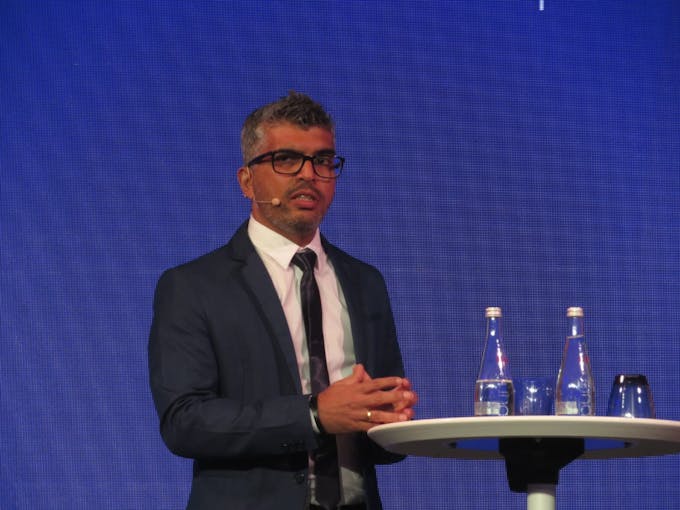It is a very traditional industry that is, even today, seen as more of an artform than a science.
To continue reading, subscribe to Eco‑Business.
There's something for everyone. We offer a range of subscription plans.
- Access our stories and receive our Insights Weekly newsletter with the free EB Member plan.
- Unlock unlimited access to our content and archive with EB Circle.
- Publish your content with EB Premium.
But the fashion industry produces about 10 per cent of the world’s greenhouse gas emissions—more than shipping and aviation combined, according to the United Nations—and could account for 26 per cent of global emissions by 2050.
Industry experts spearheading efforts to cut the industry’s environmental footprint say it has to modernise.
“Technology had a very little role [in the industry] for a long, long time. Now we’re realising what we’re missing,” Harsha Vardhan, fast fashion giant H&M’s global environment manager for production, said at the Ecosperity conference, organised by investment firm Temasek, earlier this month.
Better solutions ahead
Technology is the biggest challenge in the recycling of old or unwanted clothes, he said.

Harsha Vardhan speaking at the 2019 Ecosperity conference. Image: Eco-Business
For instance, existing technologies for the recycling of cotton will result in materials like denim or heavy fabric because of the mechanical recycling process that “basically breaks down the fabric and converts it into thicker fabric”, he told Eco-Business. “We have to find a way to get cotton fibre, and recycle it back into the cotton fibre that it was before.”
Although some chemical recycling technologies hold promise, none are commercially viable right now. “But we’re hopeful, with our investment or [through] collaboration, I think in four to five years, many of them will come to market and give us better solutions,” he said.
H&M has invested in recycling science through entities such as Worn Again, Re:newcell and the Hong Kong Research Institute of Textiles and Apparel (HKRITA).
The Swedish company’s goal is to use 100 per cent recycled or sustainably sourced materials by 2030. It hit 57 per cent last year, up from 35 per cent in 2017.
What’s out?
Recycled materials alone made up only 1.4 per cent of the total materials used by H&M last year, but Harsha is confident that one day clothes that billions of people around the world wear daily can be made from this born-again source. “If I don’t have that optimism, I wouldn’t work on this,” he said.
For now, it is difficult to estimate the proportion of H&M’s materials that will be made from recycled fabric by 2030, he said. While the company’s first goal is to use more recycled material, it also has to define, for every material it uses, what it means to be sustainably sourced.
“When you start defining, you will realise that some materials cannot be recycled or sustainably sourced; [they have] to be ruled out,” said Harsha, who has a degree in textile technology from India and a master of science in environment management and policy from Sweden’s Lund University.
H&M will phase out conventional cashmere—derived from cashmere goats—for environmental and animal welfare reasons by the end of next year, for instance. Investigations by the non-governmental organisation People for the Ethical Treatment of Animals had revealed cruelty to the goats and the cashmere industry contributing to soil degradation and desertification.
H&M is also looking into viscose, a material derived from wood pulp. It will ensure this pulp comes from well-managed forests through its partnership with non-profit group Canopy. It is also looking into chemicals used in viscose production, such as the hazardous carbon disulphide, which can affect breathing and the nervous system.
“The ideal situation is if we get to produce viscose (or a viscose-like material) by recycling, if we don’t use any wood at all and if we don’t use carbon disulphide for production,” said Harsha.
Separation, please
Last year, the H&M Foundation and HKRITA opened a recycling facility.
Clothes made from a blend of fibres are tough to recycle and the institute has come up with a way to separate cotton and polyester through hydrothermal technology that uses only heat, water and a biodegradable chemical. What results from the process is cotton in powder form and polyester in fibre form. Harsha said the institute is also working on uses for the cotton powder and on removing colour from materials that are being recycled.
At the Ecosperity conference panel session with Edwin Keh, chief executive of HKRITA, Harsha made the case for H&M moving towards a circular economy.
The company—founded in 1947—believes it has to become circular if it wants to survive for another 70 years.
Cotton is its most used material today and “we’re concerned that farmers will in future stop growing cotton and [switch to] food because there’ll be demand [to feed] a growing population”, he said. “Our second-biggest material is polyester. Polyester is oil-based and oil prices will definitely go up in future.”
Sustainability is “in crisis mode”, said Keh. Solutions should be scaled up as quickly as possible, “off the drawing boards and into real life in months, not years”.
Fashion is “art and science”, said Keh. “By holistically looking at challenges, we can do well, do good and we don’t have to sacrifice aesthetics or functionality and can do it within the time limits that we have.”
What’s the next big thing?
Asked if the fast-fashion industry itself needs an overhaul, Harsha said consuming more is not sustainable under a linear model where fibre is grown and clothes are produced, used by consumers and then disposed of in landfills.
But this will not be the case if the waste is channeled back into the system.
Companies must look at their business models and change what will not work in future, he said.
“We can’t just sit back and say, it’s worked for the last 72 years, it’ll continue to work for the next 70 years,” said Harsha.
“We have to continuously look and explore what could be changed – is the second-hand market the next big thing? Is repair and re-wear a big thing? We have four stores in Europe now [that do repairs] and we have a small workshop within the stores… Is that the new future we’re looking at?”
H&M stores collect unwanted garments from any brand and in any condition. Its global partner for the collection, sorting, reuse and recycling of used textiles and shoes is a firm called I:CO.
The H&M group collected more than 20,649 tonnes of unwanted clothes worldwide last year. The total collected in Singapore to date is 418,460kg, according to I:CO’s website.
Customers and investors must be part of the circular effort, said Harsha.
“Our consumers should understand why we’re doing it. They should bring their old clothes to our stores [and] be assured that we take care of them. They’re part of this big moment—it’s not just brands leading it,” he said.
“Investors don’t really think about circular fashion as an opportunity right now. They’re investing a lot in solar panels, and maybe some kind of water technology; they have to realise there’s a huge opportunity [in fashion]. This is the future of the fashion industry, the future of humanity.”








